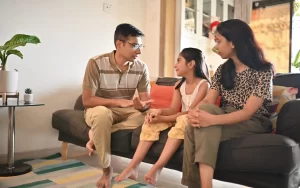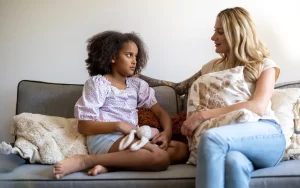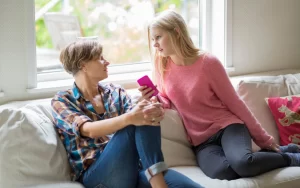Access to original Telegraph article here
How to talk to children about war
In the age of social media, our children are experiencing the visceral day-to-day reality of war in the Ukraine just like the rest of us
By Lauren Libbert28 February 2022 • 3:00pm
From close-up video footage of ground troops exchanging gunfire to bloodied faces of innocent civilians and frightened children crying in underground bunkers, lots of young people are being bombarded with images showing the brutality of war and, naturally, they’re scared.
Children as young as five and as old as 17 are asking similar questions: Why is this happening? Will the war come to us? What happens if Putin pushes the nuclear button?
“The truth is we’re all scared by this war and adults are also feeling intimidated and threatened but while the temptation might be to not talk about it to our children and even to lie to pacify them, that’s not the right way,” says clinical psychologist Dr Marianne Trent. “How you speak to them about it will depend on a child’s age, comprehension levels and emotional temperament so you have to judge that accordingly – but if you ignore their fears this will only make them worse.”
Here’s how to navigate these conversations at all ages:
Under 10s
Before talking to our children, we have to get our own fears in check.
“In our brains we have mirror neurons and we feed off and mirror the emotions of those closest to us,” says Rachel Vecht, a former primary school teacher and founder of Educating Matters supporting parents in the workplace. “Parents create the environment at home and children look to parents to see how they react to determine how they should feel themselves. You don’t have to pretend everything is great, but you also don’t need to show them you feel anxious either, as they may mirror that anxiety. It’s also important at a time like this, that usual routines are maintained and home feels as calm as possible.”
Once we have our own feelings in check, parents should ask children what they already know. “They may know a lot more or less than you think and this way you can fill in any gaps and it will frame the conversation,” says Vecht. “Children love to ask questions but when they do, gain some context by asking your own open-ended questions, such as “What do you mean by that?” “What do you think?” or “How do you feel about it? Your main job is to help your child feel safe and secure. Be an ‘emotional container vessel’ by acknowledging, validating and normalising their feelings and make sure they know they can come back to you at any time with more questions.”
The 24 hour news cycle can be anxiety-inducing for children
According to Joe Brassington, a primary school teacher and co-author of Bottled, a picture book to help children share their feelings, using the past two years and children’s experience of the pandemic can really help. “Explain to them that two years ago we were faced with Covid – something we never experienced before and didn’t know everything about and now we have answers and we got through it and we’ll do the same in this situation,” says Brassington. “Try to get them to focus on what’s happening in the Ukraine now, rather than thinking about what could happen here in the UK. In my experience, children are so much more resilient than we give them credit for, even more so after Covid.”
Vecht suggests getting a map out and showing children where the Ukraine is so they get a sense of perspective.
“They need to know that Ukraine is far away and they’re safe as this age group are mainly concerned about how it will affect their daily life,” she says. “But be careful about constantly having the news on in the background or exposing children to scary images. And if they’re anxious, give them outlets to express their emotions such as drawing, journaling, imaginative play or writing thoughts down on bits of paper and placing them in a ‘worry box’ so they can let those feelings go.”
Under 14s
Younger teens with access to phones will be receiving their information from multiple sources such as Instagram, Tik Tok or YouTube that are out of parents’ control and may well be scaremongering so the starting point will be to determine what they already know and to check for misinformation or confusion.
“At this age they’re developing their ability to do critical thinking so explore that with them and ask them what they’d want to see in this situation and why this is important to them,” suggests Dr Trent. “Treat it like a history project and help them with research whether it’s about Putin or Russian history and talk to them about fake news and where they can find reputable sources of information such as the BBC, Guardian, Bloomberg, Telegraph, which may mitigate any panic.”
Don’t forget that children are digital natives. “They’ve grown up in the digital world and are more equipped even than adults to spot a spam email so utilise their knowledge and get them to think: where is this image or video from? What is its intention?” adds Brassington.
Teens with access to phones will be invariably getting their information from sites such as Instagram, Tik Tok or YouTube.
Always create a space for open, honest conversations and ask young teens if they want to help. “Worry is trapped energy you can’t discharge so encourage them to discharge their stress by looking for avenues where they can actively help whether that’s collecting money for Ukrainian refugees or drumming up support across school,” says Dr Trent. “Check in with them regularly and make sure they know they can come to you. We can’t tell them the worst isn’t going to happen, but we can tune into them and tell them we’re going to keep them safe.”
It will also help to talk about other world conflicts that have created similar anxiety levels for us all before, and which have been resolved.
Under 18s
The impact of peers at this age is very powerful and it’s highly likely older teens may be receiving information from unreliable sources.
“Invite them to keep asking questions and check in regularly to search accurate answers and information together. Common Sense Media lists the best news sources for kids of various ages,” says Rachel Vecht. “Family meals or car journeys provide a good opportunity to share what new facts you or they may have learnt about the conflict and where that information came from.”
Entering another period of uncertainty after the two tough years of a pandemic, may be particularly difficult for an already anxious teen.
Foster a safe, open space in which your children can ask questions
“Be on the lookout for any signs of anxiety or stress, such as being unusually quiet, interrupted sleep, loss of appetite or trouble separating,” says Vecht. “A good tip to help older teens (and adults even) to manage uncertainty is to do a ‘brain dump’. Encourage them to jot down the continuous stream of thoughts in their head and then put them into two categories. What’s in your circle of control and what is out of your control? It’s good for them to articulate their thoughts but we also need to help them realise it’s a waste of time and energy to focus on what’s out of their control.”
In terms of things that they can control, one thing they can do is to investigate local charities that are helping those in Ukraine and see what they might be able to do to help.
And while older teenagers have a tendency to push parents away, try to aim for some protected time with them every day, even if it’s just ten minutes before they go to bed.
“They may not say anything but carving out a time just for them gives them an opportunity to decompress if they do have any worries,” says Trent. “As with all kids, they just need that space to air.”
Telegraph Parenting
Your essential survival guide for family life





